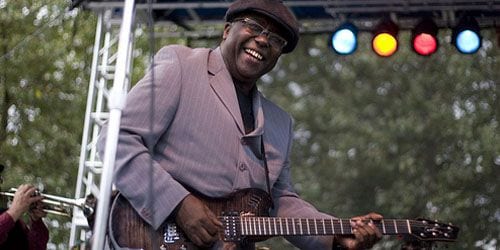
Seattle is among a handful of American cities whose name immediately evokes a certain type of music. The grunge explosion of the ’90s jerked the music world’s spotlight onto Seattle, and even after that feeding frenzy died down, the area has since maintained its reputation with a thriving indie scene. But what may come as a surprise to many is that back in the ’60s and ’70s, Seattle was a thriving haven for funk and soul bands. Then, it was over, and even the memory of that creative period seemed lost to the mists of time.
The city’s funk fortunes seem best summed up by KYAC DJ Robert Nesbitt, who worked the airwaves during those years. After searching for words, he can only throw up his hands and wonder, “Damn … what happened?”
That long-gone scene was first documented on the excellent 2006 CD, Wheedle’s Groove — Seattle’s Finest in Funk & Soul 1965-75, which proved about five seconds into its opening track, Black on White Affair’s “Bold Soul Sister, Bold Soul Brother”, that Seattle was home to damn good funk and soul. Five years later, the documentary Wheedle’s Groove: Seattle’s Forgotten Soul of the 1960’s and ’70s attempts to tell the story behind some of these unfamiliar bands. Through interviews with artists both well-known (Sir Mix-a-Lot, Mudhoney’s Mark Arms, Ben Gibbard, Quincy Jones, and others) and specific to the old Seattle soul scene, we learn about the early jazz scene that produced names like Jones and Ray Charles, and which morphed into the eclectic funk and soul scene that produced many fine bands — some of whom even had their shots at wider recognition.
In those pre-Internet days, though, the story of Seattle’s music scene was largely one of isolation, and artists like Kenny G or Jimi Hendrix had to leave in order to find their fortunes. Robbie Hill’s Family Affair performed on Dinah Shore’s show, and a couple of other bands took their shot in Los Angeles, but a city-centric label like Motown never formed that was able to define Seattle’s sound for the rest of the country. So the scene burned brightly and then apparently died at the hands of disco, only to be rediscovered by crate-diggers like Mr. Supreme, who introduces the film’s viewers to many of the bands by playing his 45s for the camera.
Wheedle’s Groove generates a good vibe from start to finish. Musicians like Ural Thomas and Ron Buford voice few regrets about not hitting the big time, and seem genuinely grateful for their years making music. Plus, the DVD ends on the high note of the Wheedle’s Groove CD release and its successful release parties and concerts, which allowed Buford, Thomas, and others to hit the stage once more.
There’s so much ground to cover, though, that the film can’t help but feel like it’s only scratching the surface. There’s the backdrop of Seattle itself, and the effects of most of Seattle’s African-American population at the time living and making music in a four-mile area called the Central District. Then there’s the racial politics of separate white and black musician’s unions despite a wealth of integrated bands, not to mention the odd arithmetic that sometimes went into determining whether a band was white or black enough to play in certain clubs. Heck, the discussion of an all-white funk band called Push and its rivalry with seemingly every other band in Seattle seems to beg for a treatment all its own. The bonus features, which consist of deleted scenes, live performances from the CD release shows, animation tests, and the trailer similarly wet your appetite for more.
As an overview of a forgotten time, though, Wheedle’s Groove succeeds on nearly every count. Thankfully, the story of Seattle’s funk and soul scene is finally being heard, and some of these musicians are finally getting some of the recognition they deserve.

![Call for Papers: All Things Reconsidered [MUSIC] May-August 2024](https://www.popmatters.com/wp-content/uploads/2024/04/all-things-reconsidered-call-music-may-2024-720x380.jpg)



